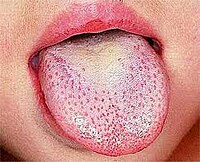
Photo from wikipedia
Purpose Understanding changes in pathogen and pneumonia prevalence among pediatric pneumonia patients is important for the prevention of infectious diseases. Methods We retrospectively analyzed data of children younger than 18… Click to show full abstract
Purpose Understanding changes in pathogen and pneumonia prevalence among pediatric pneumonia patients is important for the prevention of infectious diseases. Methods We retrospectively analyzed data of children younger than 18 years diagnosed with pneumonia at 117 Emergency Departments in Korea between 2007 and 2014. Results Over the study period, 329,380 pediatric cases of pneumonia were identified. The most frequent age group was 1–3 years old (48.6%) and the next was less than 12 months of age (17.4%). Based on International Classification of Diseases, 10th revision diagnostic codes, confirmed cases of viral pneumonia comprised 8.4% of all cases, pneumonia due to Mycoplasma pneumoniae comprised 3.8% and confirmed cases of bacterial pneumonia 1.3%. The prevalence of confirmed bacterial pneumonia decreased from 3.07% in 2007 and 4.01% in 2008 to 0.65% in 2014. The yearly rate of pneumococcal pneumonia also decreased from 0.47% in 2007 to 0.08% in 2014. A periodic prevalence of M. pneumoniae pneumonia (MP) was identified. Conclusion The increased number of patients with pneumonia, bacterial pneumonia, pleural effusion, and empyema in 2011 and 2013–2014 resulted from an MP epidemic. We provide evidence that the frequency of confirmed cases of bacterial pneumonia and pneumococcal pneumonia has declined from 2007 to 2014, which can simultaneously reflect the effectiveness of the pneumococcal conjugate vaccine.
Journal Title: Korean Journal of Pediatrics
Year Published: 2018
Link to full text (if available)
Share on Social Media: Sign Up to like & get
recommendations!